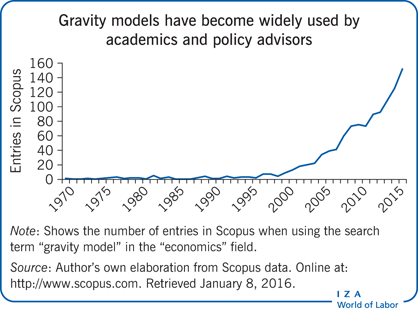Elevator pitch
Gravity models have long been popular for analyzing economic phenomena related to the movement of goods and services, capital, or even people; however, data limitations regarding migration flows have hindered their use in this context. With access to improved bilateral (country to country) data, researchers can now use gravity models to better assess the impacts of migration policy, for instance, the effects of visa restriction policies on migration flows. The specification, estimation, and interpretation of gravity models are illustrated in different contexts and limitations of current practices are described to enable policymakers to make better informed decisions.

Key findings
Pros
Gravity models provide an intuitive framework to understand the determinants of flows between countries, in particular: trade, migration, or capital.
Gravity models can easily be derived from theoretical models such as random utility maximization models.
There are multiple methods to account for analytical challenges associated with gravity models such as the use of instrumental variables or fixed effects.
Empirical models can easily be augmented to consider different additional controls and policy variables.
Cons
The estimation of gravity models requires country-pairs detailed data (i.e. data regarding two specific countries experiencing direct flows between them), which is not always easy to obtain.
Gravity models encounter difficulty when using data sets that include negative or zero values; some solutions are being investigated, but the challenge remains.
The interpretation of gravity model results from a policy perspective is not always straightforward due to questions regarding data completeness and other influencing factors.